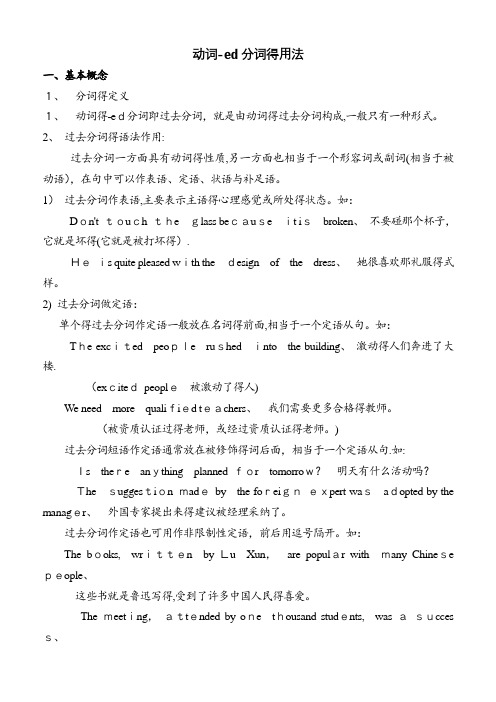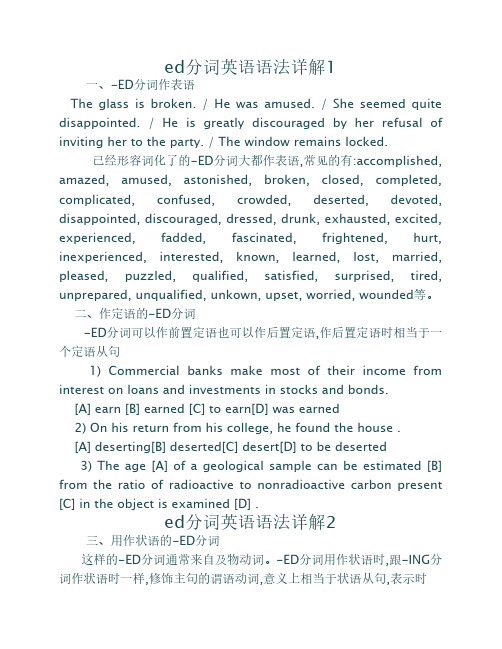-ED分词
- 格式:doc
- 大小:53.50 KB
- 文档页数:13

-ED分词-ED分词-ED分词(-ED Participle)即传统语法所指的“过去分词”(Past Participle), 是非限定动词之一。
-ED分词有两种形式:规则动词形式和不规则动词形式。
规则动词形式由规则动词+-ED 构成;不规则动词有其特殊的-ED分词。
在语法功能上,它在句子中所能承担的成分基本与-ING 分词相同,可以作表语,定语,状语,也可以用在复合结构中,不管它作什么成分,其最基本的含义是“被动”的。
-ED分词在语法功能和意义上与-ING分词有一定的区别。
一、-ED分词与-ING分词的区别虽然在语法功能上,-ED分词在句子中所能承担的成分基本与-ING分词相同,但在意义上两者有差别:-ED分词表示被动的意义而-ING分词则表示主动的意义;-ED分词表示已经完成和被动的动作而-ING分词则表示一般性的或正在进行的动作,在表现形式上,-ING分词有“一般式”和“完成式”与“主动式”和“被动式”之分;而-ED分词只有一种形式。
下边我们分析-ING 分词与-ED分词在语法功用上的区别。
1. 作表语时,-ING分词表示主语所具有的特征而-ED分词表示主语所处的状态The book is quite interesting. I am interested in the book very much.The play is more exciting than any I have ever seen.That piece of land lay deserted.2. 作状语时-ING分词表示主语正在进行的另一动作而-ED分词则表示主语发生动作的背景或情况1) Having been served lunch,_________ .[A]the problem was discussed by the members of the committee[B]the committee members discussed the problem[C]it was discussed by the committee members the problem[D]a discussion of the problem was made by the members of the committee (B) 2) _______for her anthropological(人类学的) research,Margaret Mead also was involved with(涉及) the World Federation for Mental Health.[A] She is noted primarily[B] Noted primarily[C] Primarily is noted[D] She primarily noted (B)3) Considered one of the leading poets in America today,___________ .[A]a number of books and plays have also been written by Sonia Sanchez[B]Sonia Sanchez has also written a number of books and plays[C]a number of Sonia Sanchez's books and plays have been written[D]there have been a number of books and plays written by Sonia Sanchez (B) 3. 作定语时,①-ING分词表示正在进行的动作,而-ED分词表示动作发生在谓语动词之前;②-ING分词表示它所修饰的词经常或当时的状态,而-ED分词则没有时间性;③-ING分词表示主动,而-ED分词表示被动Identify and correct:1)The boiled [A]point of any liquid [ B]is determined[C]by the pressure [D]of the surrounding gases. 将boiled 改成boiling2)High-grade [A]written [B]paper is frequently [C]obtained [D]from cotton rags.将written 改成writing3)Scientists [A]still cannot find [B]any convinced[C]link between intelligence [D]and the quantity or quality of brain cells. 将convinced 改成convincing解析:1)A错。


ed分词的用法总结一、什么是ED分词二、ED分词的基本用法1. 表示过去完成2. 表示被动语态3. 表示状态或性质一、什么是ED分词在英语中,动词的原形和过去式往往是不同的,而过去式通常使用“-ed”结尾。
这种以“-ed”结尾的形式被称为ED分词。
它不仅可以表示动作发生的时间,还可以用来描述状态、性质等,因此在英语中起着非常重要的作用。
二、ED分词的基本用法1. 表示过去完成ED分词最常见且基本的用法之一就是表示过去完成。
这种用法通常与助动词"have"或"had"连用,构成了现在完成时和过去完成时。
例如:- I have finished my homework.(我已经完成了我的作业。
)- She had done the housework before her mother came back.(她妈妈回来之前,她已经做完了家务。
)2. 表示被动语态另一个常见而重要的用法是表示被动语态。
通过将主动语态中的谓语动词转换为对应的ED分词形式,并辅以“be”系列助动词进行构成。
例如:- The book was written by Mark Twain.(这本书是马克·吐温写的。
)- The car was repaired by the mechanic.(汽车被修理工修好了。
)3. 表示状态或性质除了表示动作的完成和被动语态,ED分词还能够用来描述某个事物的状态或属性。
例如:- She was excited to receive the award.(她因获得奖项而激动。
)- The broken window needs to be fixed.(破窗户需要修理。
)以上仅是ED分词的基本用法,实际上它具有更多的变化和用途。
比如,ED 分词还可以用作形容词来修饰名词。
总结起来,ED分词在英语中使用广泛,除了表达过去完成的动作和被动语态外,还可以描述状态、性质等。

动词-ed分词得用法一、基本概念1、分词得定义1、动词得-ed分词即过去分词,就是由动词得过去分词构成,一般只有一种形式。
2、过去分词得语法作用:过去分词一方面具有动词得性质,另一方面也相当于一个形容词或副词(相当于被动语),在句中可以作表语、定语、状语与补足语。
1)过去分词作表语,主要表示主语得心理感觉或所处得状态。
如:Don't touch theglass becauseit isbroken、不要碰那个杯子,它就是坏得(它就是被打坏得).Heis quite pleased with thedesign of the dress、她很喜欢那礼服得式样。
2) 过去分词做定语:单个得过去分词作定语一般放在名词得前面,相当于一个定语从句。
如:The excited people rushedinto the building、激动得人们奔进了大楼.(excitedpeople被激动了得人)W e need more qualified teachers、我们需要更多合格得教师。
(被资质认证过得老师,或经过资质认证得老师。
)过去分词短语作定语通常放在被修饰得词后面,相当于一个定语从句.如:Is there anything planned for tomorrow?明天有什么活动吗?Thesuggestion madeby the foreignexpert wasadopted by the manager、外国专家提出来得建议被经理采纳了。
过去分词作定语也可用作非限制性定语,前后用逗号隔开。
如:The books,written by Lu Xun,are popular withmany Chinese people、这些书就是鲁迅写得,受到了许多中国人民得喜爱。
The meeting,attended by one thousand students,was asucces s、这次会议获得很大得成功,共有一千个学生出席了.3) 过去分词做状语:—ed分词与-ing分词作状语一样,也可以表示时间、原因、条件、让步、方式或伴随情况等。

ed分词英语语法详解1一、-ED分词作表语The glass is broken. / He was amused. / She seemed quite disappointed. / He is greatly discouraged by her refusal of inviting her to the party. / The window remains locked.已经形容词化了的-ED分词大都作表语,常见的有:accomplished, amazed, amused, astonished, broken, closed, completed, complicated, confused, crowded, deserted, devoted, disappointed, discouraged, dressed, drunk, exhausted, excited, experienced, fadded, fascinated, frightened, hurt, inexperienced, interested, known, learned, lost, married, pleased, puzzled, qualified, satisfied, surprised, tired, unprepared, unqualified, unkown, upset, worried, wounded等。
二、作定语的-ED分词-ED分词可以作前置定语也可以作后置定语,作后置定语时相当于一个定语从句1) Commercial banks make most of their income from interest on loans and investments in stocks and bonds.[A] earn [B] earned [C] to earn[D] was earned2) On his return from his college, he found the house .[A] deserting[B] deserted[C] desert[D] to be deserted3) The age [A] of a geological sample can be estimated [B] from the ratio of radioactive to nonradioactive carbon present [C] in the object is examined [D] .ed分词英语语法详解2三、用作状语的-ED分词这样的-ED分词通常来自及物动词。

英语专业语法ED分词讲解第22讲-ED分词22.1 –ed分词作前置定语1.来⾃及物动词的-ed分词作前置定语来⾃及物动词的–ed分词作前置修饰语通常带有被动意义和完成意义,⽽能作上述⽤法的–ing分词有的来⾃及物动词,有的来⾃不及物动词通常带有主动意义和未完成意义。
frozen food a freezing wind有些-ed分词通常不能单独⽤作前置修饰语,但若加前缀un- 或者为副词所修饰⽽构成“副词+-ed”的复合形容词以后,便可作前置修饰语。
uninvited guests badly-built house2.来⾃不及物动词的-ed分词作前置修饰语来⾃不及物动词的-ed分词很少能单独⽤作前置修饰语,能作这种⽤法的仅限于下⾯⼏个词,这些前置修饰语仅表⽰完成意义,不表⽰被动意义。
A retired worker=a worker who has retired(escaped, faded, fallen, expired, risen, returned, vanished, grown)某些来⾃不及物动词的-ed分词,单独⼀个词不可以作前置修饰语,但若与某些副词构成符合形容词,便可作前置修饰语。
22.2-ed 分词作补语能⽤作补语的-ed分词也⼤都来⾃及物动词。
凡是已经形容词化了的-ed分词,⼤都可以既作名词修饰语⼜作主语补语或宾语补语。
The door remains locked.古英语遗留下来的⼏个-ed分词的⽤法问题。
1.古英语遗留下来的⼏个–ed分词的⽤法问题在现代英语中,还有少数从古英语遗留下来,现在只⽤作形容词的-ed分词,有的在形式上与⼀般的-ed分词不同,有的在⽤作名词修饰语或补语时各采2.可以带-ed分词作宾补的动词有以下三类第⼀类see, hear, feel, find, think等表⽰感觉和⼼理状态的动词:第⼆类make, get, have, keep 等表⽰“致使”意义的动词:注:在“have+宾语+-ed分词“这⼀结构中,have有三种不同意义We had the problem solved. 表致使,⼀种有意的⾏为。
英语中的分词在英语中,分词(Participles)是一种动词的非限定形式,通常以-ing(现在分词)或-ed、-en、-t、-n(过去分词)结尾。
分词可以用作形容词,也可以用在一些复杂的动词时态中。
以下是关于分词的主要用法:●现在分词(Present Participle):1.以-ing结尾,如"playing," "reading," "walking"。
2.作为形容词使用,描述正在进行的动作或事物的特征。
例句:The playing children seemed happy.翻译:玩耍的孩子们似乎很开心。
3.用于进行时态(Present Continuous Tense)。
例句:She is reading a book.翻译:她正在读一本书。
●过去分词(Past Participle):1.过去分词的形式有多种,通常以-ed结尾,如"played," "talked";也可以是不规则的形式,如"broken," "written"。
2.作为形容词使用,描述已完成的动作或事物的状态。
例句:The broken window needs to be fixed.翻译:需要修理的破窗户。
3.用于完成时态(Present Perfect Tense, Past Perfect Tense)。
例句:They have eaten lunch already.翻译:他们已经吃过午餐了。
4.用于被动语态。
例句:The letter was written by Tom.翻译:这封信是汤姆写的。
分词在英语中也有其他一些用法,如独立分词、分词短语等。
分词的灵活运用可以使语言更富有表现力和变化。
ed分词英语语法详解1一、-ED分词作表语The glass is broken. / He was amused. / She seemed quite disappointed. / He is greatly discouraged by her refusal of inviting her to the party. / The window remains locked.已经形容词化了的-ED分词大都作表语,常见的有:accomplished, amazed, amused, astonished, broken, closed, completed, complicated, confused, crowded, deserted, devoted, disappointed, discouraged, dressed, drunk, exhausted, excited, experienced, fadded, fascinated, frightened, hurt, inexperienced, interested, known, learned, lost, married, pleased, puzzled, qualified, satisfied, surprised, tired, unprepared, unqualified, unkown, upset, worried, wounded等。
二、作定语的-ED分词-ED分词可以作前置定语也可以作后置定语,作后置定语时相当于一个定语从句1) Commercial banks make most of their income from interest on loans and investments in stocks and bonds.[A] earn [B] earned [C] to earn[D] was earned2) On his return from his college, he found the house .[A] deserting[B] deserted[C] desert[D] to be deserted3) The age [A] of a geological sample can be estimated [B] from the ratio of radioactive to nonradioactive carbon present [C] in the object is examined [D] .ed分词英语语法详解2三、用作状语的-ED分词这样的-ED分词通常来自及物动词。
-ing分词、过去式和-ed分词构成规律-ing分词和-ed分词构成规律(简版)1. 一般动词加-ing, -ed: working, worked;2. 以e结尾的(-ee, -oe, -ye, -ie除外),去e 加-ing, -ed;以-ie结尾的变-ie为-y再加-ing(但-ed分词则直接加–d):如hope→hoping, hoped; 但agree→agreeing, agreed; hoe(锄)→hoeing, hoed; dye→dyeing, dyed; tie→tying, tied.另外,age→ageing, aged; singe(烧/烫焦)→ singeing, singed.3. 以一个元音+一个辅音(w和x除外)结尾的重读音节出现在第2个音节重读的双音节或单音节词中,双写该末尾辅音字母后,加-ing, -ed:如admit→admitting, admitted; stop→stopping, stopped;但snow→snowing, snowed; fix→fixing, fixed. 个别以非重读结尾的也须双写该末尾辅音字母后,加-ing, -ed:如(telegram),humbug(欺骗)→humbugging, humbugged;4. 两个元音字母+一个辅音字母结尾的直接加-ing, -ed:如rain→raining, rained;5. 以一个辅音字母+y结尾的,变y为i再加-ed(但直接加-ing):如(worried, 但worrying);以一个元音字母+y结尾的,直接加-ed和-ing:如(enjoyed);6. 以l结尾的动词,在英国英语中双写l再加-ed和-ing,在美国英语中直接加-ed 和-ing:如(travel);7. 以-ic结尾的加k后再加-ed和-ing:如(picnic→picnicking, picnicked).规则动词过去式、过去分词(即-ed分词)的构成规律规则动词:A.—般加-ed。
-ED分词
一. –ed分词作前置修饰语
1.来自及物动词的-ed分词作前置修饰语
来自及物动词的-ed分词作前置修饰语通常带有被动意义和完成意义;而能作上述用法的–ing分词有的来自及物动词,有的来自不及物动词,通常带有主动意义和未完成意义。
试比较:
frozen food a freezing wind
a bored traveler a boring journey
a lost cause a losing battle
a conquered army a conquering army
a finished article the last finishing touch
the spoken word a speaking bird
a recorded talk a recording machine
a closed shop the closing hour
written language writing paper
有些-ed分词通常不能单独用作前置修饰语,但若加前缀un-或者为副词所修饰而构成“副词+ -ed分词”的复合形容词以后,便可作前置修饰语,例:
uninvited guests badly- built house
untold sufferings far-fetched reasons
unheard-of stories newly-born children
2.来自不及物动词的-ed分词作前置修饰语
来自不及物动词的-ed分词很少能单独用作前置修饰语,能作这种用法的仅限于retired, escaped, faded, withered, fallen, expired, risen, returned, vanished, grown这几个词,这些前置修饰语仅表示完成意义,不表示被动意义,例:
a retired worker = a worker who has retired
an escaped prisoner = a prisoner who has escaped
the risen sun = the sun that has just risen
某些来自不及物动词的-ed分词,单独一个词不可以作前置修饰语(如不可说“a behaved boy, a traveled businessman”),但若与某些副词构成复合形容词,便可作前置修饰语,例:well-behaved children = children who behave well
a widely-traveled businessman = one who has traveled widely
二. –ed分词作补语
能用作补语的-ed分词也大都来自及物动词。
凡是已经形容词化了的-ed分词,大都可以既作名词修饰语又作主语补语或宾语补语,例:
The door remains locked.
I found the door locked.
I found a locked door.
1.古英语遗留下来的几个-ed分词的用法问题
在现代英语中,还有少数从古英语遗留下来、现在只用作形容词的-ed分词,有的在形式上与一般-ed分词不同,有的在用作名词修饰语或补语时采取不同形式,列表如下:
观察上述一般-ed分词与作形容词用的-ed分词的用法:
A lighted candle is one that has been lit.
A drunken man is one who has drunk too much alcohol and has got drunk.
2.能带-ed分词作宾语补语的动词分类
1)包括see, hear, feel, find, think,等表示感觉和心理状态的
动词,例:
I saw the students assembled in the hall.
We found her greatly changed.
2)包括make, get, have, keep等表示“致使”意义的动词,
例:
I have my hair cut every month.
He was trying to make himself understood.
Please keep us informed of the latest developments.
3)包括like, want, wish, order等表示希望、要求、命令等意
义的动词,例:
I don’t want any of you (to be) involved in the scandal.
The viewers wish the serial film (to be) continued.
三.关于“悬垂分词”
悬垂分词,又叫“无依着分词”,指-ing分词或-ed分词结构在句中找不到它的逻辑主语,因而处于一种“悬垂”状态,即“无依着”状态。
1.“依着法则”和“悬垂分词”
当-ing分词或-ed分词结构在句中起关系分句或状语分句作用时,这种逻辑主语有时就是主句的主语,例:
Sitting at the back as we are, we can’t hear a word.
Jolted by the collision, Harry suffered a sprained back and a doctor.
但有时,分词结构的逻辑主语并不是主句的主语,而是主句的其他成分
Searching along the deck, it had taken him some time to find a doctor.
由上述各个例子可以看出,分词结构通常是通过它的逻辑主语而对主句发生依着关系,这种语法现象叫做“依着法则”。
相反地,如果一个分词结构在句中找不到它的逻辑主语或者依着在不该依着的词语上,就成了“悬垂分词”或“无依着分词”,例:
Having eaten our lunch, the car pushed its way through the tortuous canyon.
2.关于“悬垂分词”的可接受性问题
关于“悬垂分词”的可接受性,应对具体问题作具体分析,比如在科技语体中,“悬垂分词”以及无依着的不定式结构用得较多,这应视为正常,因为科技语体通常避免使用人称主语,例:
Using the electric energy, it is necessary to change its form. 在其他语体中,只要“悬垂分词”不引起歧义或造成语义混乱,通常是可以接受的,例:
Leaving the cinema, it seemed to him that the film had been exceptionally bad.
但是,在脱离了上下文的情况下,有些“悬垂”
现象却应该避免,例:
Standing on the church tower, the whole village could be seen.
而有些“悬垂分词”结构,在理解上会引起歧义或者在表意上会引起混乱,这种“悬垂分词”是不可接受的,例:Opening the cupboard, a skeleton fell out.。